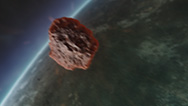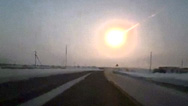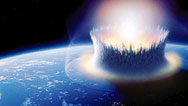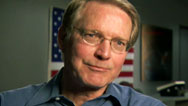Asteroid
- Posted 09.03.06
- NOVA scienceNOW
(This video is no longer available for streaming.) The Apophis asteroid appears in telescopes as nothing more than a moving speck of light. But the latest data tell us that this rock is bigger than the Rose Bowl and is hurtling towards Earth on what could be a collision course. Most unsettling, if it struck it would release the energy of 100 nuclear bombs. NOVA scienceNOW host Neil Tyson investigates this disturbing threat in our solar system.
Transcript
ASTEROID
PBS Airdate: October 3, 2006
NEIL DEGRASSE TYSON: Welcome to a new season of NOVA scienceNOW. I'm Neil deGrasse Tyson, astrophysicist and your host. In each show, we'll bring you several stories, breaking news from the frontiers of science. You'll meet my fellow scientists exploring the universe, from the tiniest microbes to the farthest reaches of the cosmos.
First, let's take a look at our own solar system. It can seem like an orderly place, where the planets chug along in their orbits like trains on a track. But there's no guarantee those tracks will remain clear, because in addition to the planets, there's a lot of other stuff in the solar system, and eventually their paths will cross.
Now, if you happen to live on one of those planets, that would be bad.
One night in 2004, telescopes spotted a tiny dot moving across the sky. That dot was actually an asteroid named Apophis, and it seemed to be headed towards Earth.
When seen even through our most powerful telescopes, Apophis shows up as nothing more than just a moving speck of light, but the latest data tell us that this asteroid may be as wide as a thousand feet. That's bigger than the Rose Bowl.
Now imagine that hunk of rock hurtling through space, on a collision course with Earth. It sounds like something from the movies. Remember Deep Impact? Or Armageddon?
BRUCE WILLIS (Clip from Armageddon): Rise and shine.
NEIL DEGRASSE TYSON: Where Bruce Willis saves the world? The movies were a little silly—somehow, all the flaming fragments in Armageddon had good aim and hit only famous buildings—but they were inspired by a basic and frightening truth about our solar system.
It's easy to think of the solar system as a big, wide-open playing field: the sun in the middle, and just a few planets in orbit around it. But in fact, between the planets, it's filled with debris of all sizes, some as small as a pea, others as large as cars, houses, even mountains. We've been hit before by these things. And you know something else? We're going to get hit again.
In space, they're just cold hunks of rock, but when they plunge into Earth's atmosphere, at 30- or 40,000 miles an hour, their surface glows red hot.
Small objects will burn up before hitting the ground. We call those "shooting stars." But the bigger ones will keep on coming and explode on impact. If you know where to look, you can see the damage caused by past impacts all around us. Our moon is scarred with countless craters.
Here on Earth, this mile-wide hole in the Arizona desert was blasted by an asteroid as big as an office building. And 65,000,000 years ago, a rock the size of Mount Everest slammed into the Yucatan. That's the one that triggered the demise of the dinosaurs.
Our long history of getting in the way of asteroids worries Apollo astronaut Rusty Schweickart.
RUSTY SCHWEICKART: I mean, an asteroid can literally destroy 80 or 90 percent of the species that are alive on Earth. These are big events. I mean, this is called extinction.
NEIL DEGRASSE TYSON: To guard against catastrophe, a team at NASA tracks asteroids, including that potentially lethal one, Apophis, named for an Egyptian god of darkness and evil.
PAUL CHODAS (NASA/Jet Propulsion Laboratory): It was clear that it was going to be a very close approach and fascinating object.
NEIL DEGRASSE TYSON: In late 2004, with just a few observations to go on, the team came up with a frightening prediction.
STEVE CHESLEY (NASA/Jet Propulsion Laboratory): Very often, they start at one in a million, maybe even one in a billion. In this case, the maximum probability was about 1 in 37.
NEIL DEGRASSE TYSON: One in 37 chance that in April of the year 2029, Apophis would slam into Earth on, get this, Friday the 13th.
STEVE CHESLEY: ...never seen anything like that before. That was absolutely extraordinary.
NEIL DEGRASSE TYSON: Extraordinary, indeed, but not necessarily right. The NASA team has to continually revise its predictions.
DON YEOMANS (NASA/Jet Propulsion Laboratory): It's much like predicting a hurricane: when it's first spotted, you don't know where it's going to hit. As you get more and more information on its track, you can predict where it's going to go.
NEIL DEGRASSE TYSON: It turned out that Friday the 13th, 2029, wouldn't be so unlucky after all. Apophis will not hit us that day, but the asteroid will come frighteningly close to Earth.
PAUL CHODAS: It's going to come 10 times closer to us than the Moon is. So it's actually going to pass closer to us than the ring of satellites—communications satellites—that are in synchronous altitude around the Earth.
NEIL DEGRASSE TYSON: Such a near miss means that Earth's gravity will dramatically alter the asteroid's orbit. Problem is, as its path bends, there's one small region of space we do not want Apophis to pass through. Chodas named it "the keyhole."
PAUL CHODAS: If it should pass through that little keyhole, then it would be on a collision course at a later encounter.
Now if I advance it after 2029, you can see...
NEIL DEGRASSE TYSON: If the asteroid passes through the keyhole, then seven years later, in 2036, Apophis will be headed right for us. So, what if that one possibility actually happened? What kind of damage could an asteroid the size of the Rose Bowl do?
JONATHAN GIORGINI: If Apophis did impact, it would impact at around seven and a half miles per second, and all that energy has to go somewhere. It would leave a blast area of around 60 to 100 miles across, and it would dissipate energy about equal to 100 nuclear bombs going off at the same time.
NEIL DEGRASSE TYSON: An asteroid the size of Apophis, if it hit land, could devastate several counties in, say, southern California. But if Apophis passes through the center of the keyhole, it will slam into the Pacific Ocean, nearly 1,000 miles off the California Coast, and that could be a lot worse.
RUSTY SCHWEICKART: If it hits in the ocean or in the water, it's going to create a very significant tsunami.
NEIL DEGRASSE TYSON: I met up with Rusty Schweickart to find out what that tsunami might do to Santa Monica Beach.
RUSTY SCHWEICKART: We would have three and a half hours of waves, 55 feet high and larger, crashing onto this shore.
NEIL DEGRASSE TYSON: So, not just a simple rise in the water level that we saw in the Indonesia tsunami, you're talking about a surfable wave.
RUSTY SCHWEICKART: That yellow building will be gone.
NEIL DEGRASSE TYSON: So it's basically going to chew its way into the coastline.
RUSTY SCHWEICKART: It's going to sandpaper the whole coast, all the way up and down, from the Panama Canal all the way up to Alaska.
NEIL DEGRASSE TYSON: So if this, or any other asteroid, has our name on it, do we just run for our lives? Or could we actually do something about it?
RUSTY SCHWEICKART: Unlike any other natural disaster, especially the big natural disasters that we know of, this one—if we use our brains—we can prevent. We don't just prepare for it; we can literally stop it from happening.
NEIL DEGRASSE TYSON: What you're saying is, we don't know how to turn off a volcano yet, we don't know how to undo a hurricane.
RUSTY SCHWEICKART: That's right.
NEIL DEGRASSE TYSON: This is—this is one of the great natural disasters that we have the power, the knowledge, the means of avoiding. In the big asteroid movies, the solution seems to always be the same: send up some action heroes and nuke the thing.
RUSTY SCHWEICKART: That's a very, very bad way to try and deflect an asteroid that's headed for the Earth. You're going to certainly have a lot of debris, so that stuff is going to end up hitting the Earth anyway. You don't know what's going to happen.
NEIL DEGRASSE TYSON: But if nuclear weapons aren't the best defense against asteroids, what is?
DON YEOMANS: If it's a small object, you could simply run into it, slow it down, or speed it up, so that in 20 or 30 years, when it was predicted to hit the Earth, it would be slowed down just enough that it would miss the Earth, or sped up just enough that it would miss the Earth.
NEIL DEGRASSE TYSON: Just recently, NASA slammed a spaceship into a comet. They weren't trying to deflect it, just study what it's made of. But before you could successfully deflect a hunk of rock like Apophis, you'd have to know its exact shape and structure.
Lance Benner studies asteroids with radar, by bouncing radio waves off the rocks.
LANCE BENNER (NASA/Jet Propulsion Laboratory): The radar imaging of asteroids has revealed a completely bewildering zoo of different shapes and sizes. We see objects like this one that's roughly the shape of a cucumber. We see many that look like potatoes. We're seeing a surprising number that are actually spheres.
NEIL DEGRASSE TYSON: There's even one that looks like a dog bone.
And what about Apophis?
LANCE BENNER: We know very little about Apophis, unfortunately. We have a crude estimate of its size. We don't know anything detailed about its shape. We don't know if it's a porous object.
NEIL DEGRASSE TYSON: Deflecting a weirdly shaped or porous object would be a challenge. A more flexible solution might be a "gravitational tractor." The idea is, send an unmanned spacecraft up to the asteroid, and have it fly just ahead of the rock. Then the spaceship's gravity can, over time, work to subtly change the asteroid's speed, putting it on a slightly different orbit.
RUSTY SCHWEICKART: If you use a gravitational tractor, where you're pulling it using gravity as a tow rope, you know precisely what you're doing and what's happening to the asteroid all the time.
NEIL DEGRASSE TYSON: For Rusty Schweickart, the consequences of failure are so dire, he believes NASA needs to demonstrate this technique now.
RUSTY SCHWEICKART: I think the world public is going to want to know for certain that something's going to work, when you go up and try to, you know, deflect an asteroid from wiping out life. They're not going to want to hear a bunch of scientists say, "Well, we think it'll work," or, "It's 80 percent probability," or, "95 percent probability." You know, you're going to want to know.
NEIL DEGRASSE TYSON: Not everyone thinks we should be spending a couple hundred million dollars on a deflection mission anytime soon.
DON YEOMANS: I'm of the opinion that the majority of the resources that NASA's devoting to this effort should be in searching for these objects and finding them—finding them early, finding them early, finding them early.
NEIL DEGRASSE TYSON: We know of about 4,000 near-Earth asteroids, but recent estimates tell us that estimate there's thousands more, just as deadly, that we have yet to discover.
DON YEOMANS: An object like Apophis is just the tip of the iceberg. So my concern is not with this individual object, my concern is the tens of thousands of these objects that we haven't yet discovered, and that could take us by surprise if we don't discover them.
Credits
Asteroid
- Edited by
- Dick Bartlett
- Written, Produced and Directed by
- Julia Cort
NOVA scienceNOW
- Executive Producer
- Samuel Fine
- Executive Editor
- Neil deGrasse Tyson
- Senior Series Producer
- Vincent Liota
- Supervising Producer
- Stephen Sweigart
- Development Producer
- Vinita Mehta
- Program Editor
- David Chmura
- Associate Producers
- Win Rosenfeld
Anthony Manupelli
Mica McCarthy
Shimona Shahi
Mary Robertson
Shannon Guirl
Courtney Kline - Unit Manager
- Candace White
- Production Secretary
- Fran Laks
- Animator
- Brian Edgerton
- Music
- Rob Morsberger
- Song: "The Elements" Music and Lyrics by
- Tom Lehrer
- NOVA scienceNOW Series Animation
- Edgeworx
- Camera
- Vincent Liota
Peter Bonilla
Mike Coles
Brian Dowley
Anthony Forma - Sound Recordists
- Adriano Bravo
John Cameron
Michael Karas
John O'Connor
Keith Rodgerson
Allen Stith - Audio Mix
- John Jenkins
- Colorist
- Mark Steele
- Animation
-
Vincent Liota
Sputnik - Animation
- Three-dimensional animations courtesy of LONI and the Center for Computational Biology in collaboration with the National Institutes of Mental Health. Principal Investigator: Arthur W. Toga, Animators: Ken Nakada, Tomokatsu Shoji, Hideo Kumagai, Amanda Hammond, Kim Hager, Andrew Lee & John Bacheller
- Special Thanks
- Software Bisque
- Archival Material
- Allen Friensehner/LLNL
Joint Institute for Nuclear Research at Dubna
Maas Digital LLC
NASA /Jet Propulsion Laboratory
NASA/JPL/Cornell
Aerial shot of JPL courtesy NASA/JPL-Caltech
Jennifer Hulshizer/Star Ledger/Corbis - Archival Playboy Magazine material provided by Playboy. Used with Permission. All rights reserved.
- NOVA Series Graphics
- yU + co.
- NOVA Theme Music
- Walter Werzowa
John Luker
Musikvergnuegen, Inc. - Additional NOVA Theme Music
- Ray Loring
- Post Production Online Editors
- Spencer Gentry
Mark Steele - Closed Captioning
- The Caption Center
- NOVA Administrator
- Dara Bourne
- Publicity
-
Eileen Campion
Olivia Wong - Researcher
- Gaia Remerowski
- Production Coordinator
- Linda Callahan
- Unit Managers
- Carla Raimer
Karen Lally - Paralegal
- Raphael Nemes
- Legal Counsel
- Susan Rosen Shishko
- Post Production Assistant
- Josh Thurston
- Assistant Editor
- Alex Kreuter
- Associate Producer, Post Production
- Patrick Carey
- Post Production Supervisor
- Regina O'Toole
- Post Production Editor
- Rebecca Nieto
- Post Production Manager
- Nathan Gunner
- Producer, Special Projects
- Susanne Simpson
- Coordinating Producer
- Laurie Cahalane
- Senior Science Editor
- Evan Hadingham
- Senior Series Producer
- Melanie Wallace
- Managing Director
- Alan Ritsko
- Senior Executive Producer
- Paula S. Apsell
This material is based upon work supported by the National Science Foundation under Grant No. 0229297. Any opinions, findings, and conclusions or recommendations expressed in this material are those of the author(s) and do not necessarily reflect the views of the National Science Foundation.
NOVA scienceNOW is a trademark of the WGBH Educational Foundation.
NOVA scienceNOW is produced for WGBH/Boston by NOVA.
© 2006 WGBH Educational Foundation
All rights reserved
- Image credit: (asteroid hitting Earth) © NOVA/WGBH Educational Foundation
Participants
- Lance Benner
- NASA/Jet Propulsion Laboratory science.jpl.nasa.gov/people/Benner/
- Steve Chesley
- NASA/Jet Propulsion Laboratory
- Paul Chodas
- NASA/Jet Propulsion Laboratory neo.jpl.nasa.gov/
- Jon Giorgini
- NASA/Jet Propulsion Laboratory neo.jpl.nasa.gov/
- Rusty Schweickart
- B612 Foundation www.well.com/~rs/
- Don Yeomans
- NASA/Jet Propulsion Laboratory deepimpact.jpl.nasa.gov/science/dyeomans.html
Related Links
-

Asteroid: Doomsday or Payday?
Will future asteroids trigger massive extinctions—or be mined for precious minerals?
-

Meteor Strike
A meteor burst into a fireball over Siberia. Can we spot the next deadly asteroid in time?
-

The Asteroid That Hit L.A.
Use a catastrophe calculator to try out some "what-if" scenarios regarding an asteroid potentially striking Los Angeles.
-

Asteroid: Expert Q&A
NASA's Don Yeomans answers questions about Apophis and the asteroid threat in general.



